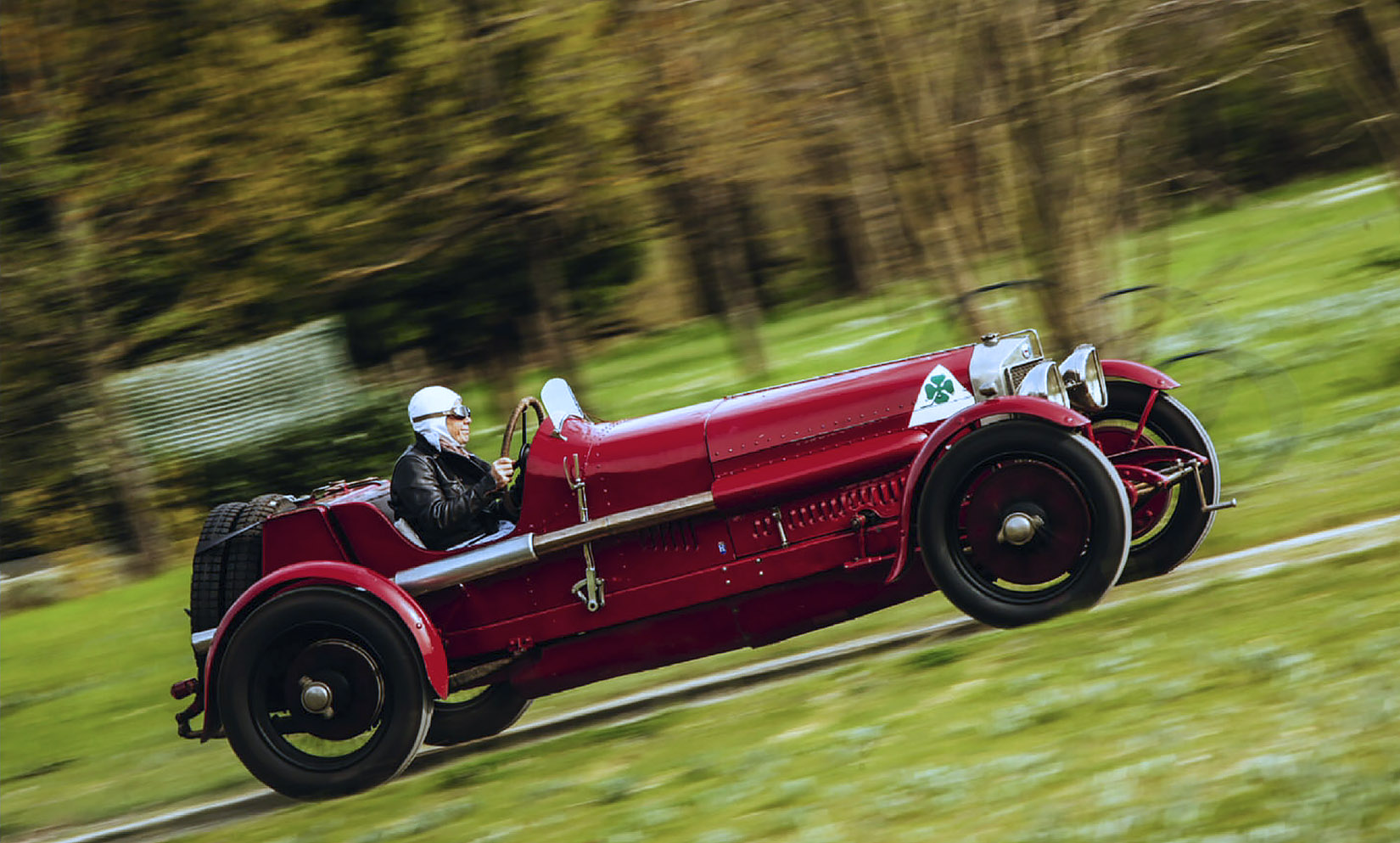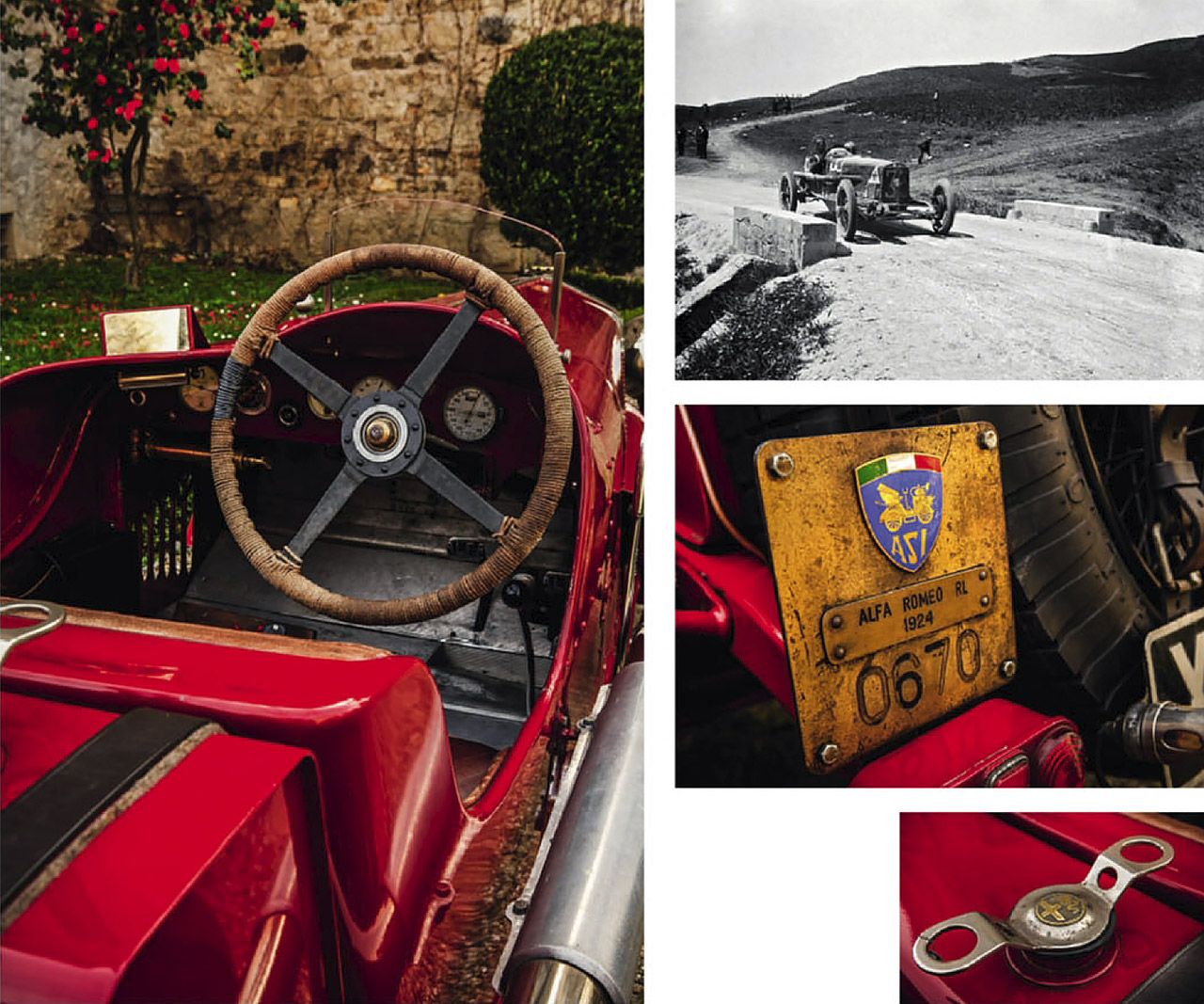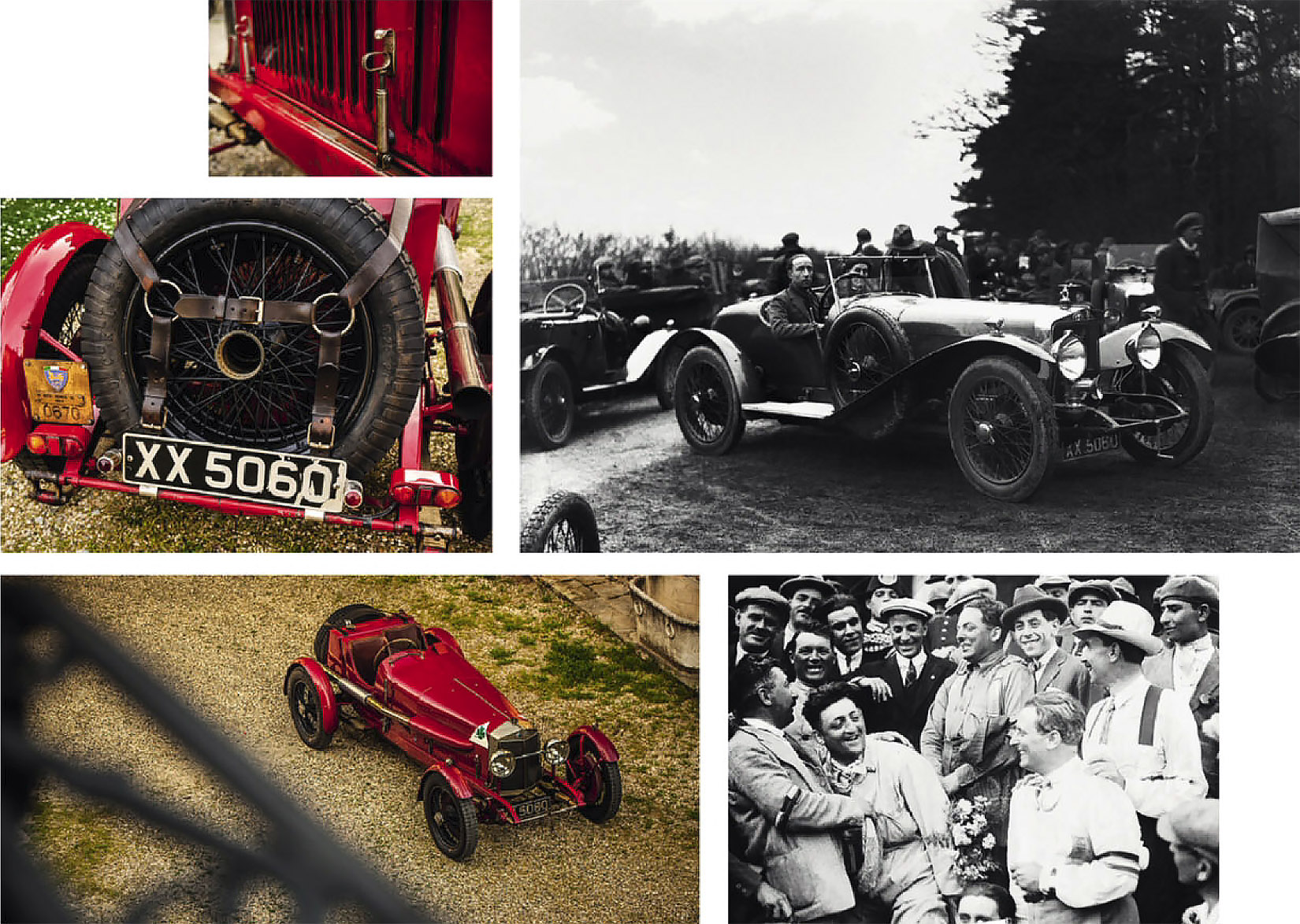
Campari’s road-racer. The Alfa Romeo RL kick-started the great Milanese marque’s illustrious motor sport tradition. Mick Walsh drives the only surviving Targa Florio team car. Photography Tony Baker/LAT.
Certain car types are synonymous with a single event, and 1924 Alfa Romeo’s vintage RL series will always be associated with the Targa Florio, the tough Sicilian road race that back in the 1920s ran for more than seven hours. The 1923 fixture may have had only 17 starters but it was fully international in its line-up. Alfa Corse fielded three new 3-litre RLs for a squad-rone of Giuseppe Campari, Antonio Ascari and two-time Targa winner Count Giulio Masetti – plus a young Enzo Ferrari and Ugo Sivocci in bored-out 3.2-litre models.

The Madonie circuit was in a rough state due to heavy rain the night before, more a loose dirt track than a road. The German Steyr team set the pace, with Hermann Rutzler the quickest followed by Campari, but all eyes around the 108km circuit were on Ascari as his charge was delayed by an off-road excursion on lap three. After hastily replacing the burst tyre, Ascari gunned the Alfa after the leaders and on the final lap the locals were already cheering his certain victory. But the engine failed as the finish came into sight, and the stunned crowds watched as the Mantuan struggled to restart.
Before his teammate Sivocci arrived, the car fired up and Ascari motored off with bonnet removed and three helpers hanging on to the body, including riding mechanic Giulio Ramponi. The officials were infuriated and demanded that Ascari return to the stopping place and drive back solo to qualify. How this task was achieved is not recorded, but just imagine the Alfa reversing against the flow of the other competitors! Frustratingly, Sivocci had caught up and cruised past to win as Ascari began accelerating forward again to finish second. Ferrari had less luck, retiring after a dramatic accident at the end of the first lap when he over-shot the course and rolled near Cerda.

Clockwise, from left: roomy cockpit with cord- bound wheel; Campari on the ’24 Targa in TF11; ASI historic plate; fast-access fuel-filler cap. Far right: dramatic lines with low radiator and long bonnet.
The event marked Alfa’s first international victory and the lucky four-leaf clover that adorned the winning car became a universal Alfa sporting emblem in honour of Sivocci, who didn’t see out the year after a fatal Monza practice accident in the new Grand Prix P1.
The RL racers took several victories in Italian events and, as secret development focused on a new P2 Grand Prix challenger, a team of RLs was again prepared for the Targa Florio. For 1924, the field was up to 37 entries. French ace Louis Wagner joined Ascari and Campari in the factory squad while Giulio Masetti ran a private RL. The opposition included works teams from Ballot, Peugeot, Fiat, Itala, Steyr and Mercedes – which brought three new 2-litre GP designs.
Masetti led the first lap before Christian Werner’s white Mercedes took control, but no one expected the exotic German twin-cam design to finish. On the final lap, Ascari began another dramatic comeback charge but, just as victory looked to be his, the engine seized on the last corner. Both driver and mechanic jumped out to push the dead Alfa home but Masetti blasted past them, with an exhausted Ascari finally coming third. To make matters worse, he was eventually disqualified for outside assistance after spectators helped to push the broken Alfa to the finish. That promoted Campari to fourth, missing out on third by only 17 secs after nearly seven hours’ racing, but the team was by then focused on greater Grand Prix glory.
Of all those Alfa Romeo Targa Florio team cars, only our featured example – Campari’s chassis TF11 – survives. These works racers were no prototype exotics but closely based on the RL touring models designed by the firm’s engineering director Giuseppe Merosi and introduced in 1922. The chassis was a conventional semi-elliptically sprung frame with a 2994cc pushrod straight-six giving 56bhp.
The new model’s excellent handling and strong low-down torque were quickly developed for a sports version – the Type RLS – with uprated 71bhp engine thanks to twin updraught Zenith carburettors and a quick-lift camshaft. With shortened wheelbase, four-wheel brakes, distinctive vee-shaped radiator and handsome open bodywork by Italy’s finest coachbuilders, including Castagna, it rivalled the Bentley 3 Litre and Vauxhall 30-98. The advertising for the £950 two-seater claimed it to be ‘The World’s Finest Sports Car’ – customers included Benito Mussolini, who remained a great supporter of Alfa throughout his dictatorship.
The fastest touring models – namely the final development, the RL SS – were good for 90mph with superb handling and steering to match. Lower gear ratios were closely matched and ideal for Alpine testing, but the chasm between third and top was as wide as the River Po.
A competition version was also developed featuring a lighter chassis, an even shorter wheelbase, a tuned four-bearing engine with dry-sump lubrication and a close-ratio gearbox. A small series of seven-bearing Targa Florio engines was also built for 1924. The racing models featured a lower radiator and longer bonnet with rear body tapered around the seats, exposed fuel tank and twin spares strapped to the back. In 1923, the radiator was cowled for token streamlining but for the final ’24 season the production-style vee-radiator design was adopted, together with a larger fuel tank. After the 1923 victory in Sicily, the short-chassis racing series was christened the RL TF.
I love the early competition images of these dark, slab-tanked, open-wheel machines blasting along dusty roads on tall, skinny, beaded-edge tyres, and it’s easy to appreciate how Alfa’s reputation for great handling was founded with these handsome sports-racers. Where better to fine-tune a sublime chassis than on twisty Italian passes?
Just climbing into the cockpit of this RL TF team car evokes those epic road races. The easiest route into the staggered seats is via the passenger side to avoid the hot external exhaust, using the rear spring shackle as a step. The controls are dominated by the broad four-spoke steering wheel with cord-wrapped rim. Beneath the scuttle is a random spread of dials – fuel pressure and oil temperature to the left for the mechanic, and rev counter and speedometer to the right for the driver. The floor is ribbed steel with a sunken section for useful heel support. The central throttle is a ‘button’ type, while the brake and clutch pedals are neatly cast with ‘ALFA’ and ‘ROMEO’ respectively.
As on a Bentley, the gearchange is situated inside the bodywork, the short lever working through a conventional H-gate with first to the left and forward, and top out and back. Reverse is an extension of the slot for first, but is thank-fully protected by a hinged guard. Only the driver gets an aero ’screen.
The first step to starting is pressurising the tank, which is done via a hand pump that neatly swings out from under the dash. The smooth 3-litre ‘six’ erupts with a deep burble and, thanks to the torque and short gearing, the response is urgent. With the light clutch and lively revs, the ’box is a treat to work as you double-declutch up and down the chunky cast-brass gate. The brakes are superb by vintage standards, the pedal giving plenty of feel, while the steering is light and direct – even with later triple-stud-style tyres.
Running on an authentic loose track with the new owner enthusiastically encouraging an ever- fasterpace to create dust, I relish every minute at the wheel of the oldest Alfa I’ve driven. Into the sharper bends, the RL TF naturally wants to understeer, but it’s easy to unstick the rear and drift around on the power. Storming up the hilly route and into hairpin bends, the hazy low sun filtered by the Alfa’s dusty wake, it’s easy to imagine we’re chasing Andre Dubonnet’s Hispano H6C on the rough road up to Caltavuturo.
Climbing into the team car’s cockpit evokes those epic road races.
Marking the transition from the Edwardian to the vintage era, the RL TF combines the best of both with its light controls, torquey long-stroke power unit and improved brakes. Merosi set an amazing benchmark for his successor Vittorio Jano, but what a shame that so few remain.
Like many historic vintage cars, the Alfa’s survival is thanks to British enthusiasts. In 1924 at the French Grand Prix, an Englishman named LG Styles was so impressed by Campari’s winning performance in the P2 that he decided to extend his holiday and travel to Milan to visit the Alfa Romeo factory. Nicola Romeo himself gave Styles a guided tour, and by the end of the visit they were discussing a contract for the sole Alfa concession in Great Britain.
The first car bought was a special 3-litre 22/90 RL TF – chassis TF11. ‘It had a lower radiator and narrower chassis than the standard models,’ wrote Styles in the AROC magazine. ‘It was lightened and was fitted with a balanced seven- bearing crank with raised compression ratio.’
Back in England, Styles set about launching the Italian marque from new premises at 54 Baker Street in London. The RL TF chassis was sent to coachbuilder AE Leadbetter, where it was fitted with a striking two-seater pointed-tail sports body. Registered XX 5060, it became a regular star entry at speed events. Styles was clearly a smart marketing man because the new car was continually repainted from shell granite to black, then gold and eventually blue. Major Charles G Coe was initially enlisted to drive and, on 28 March 1925, the rakish Alfa made its debut at Kop Hill near Princes Risborough, where it scored several class wins at the last competition hillclimb run on public roads in Britain.
Styles continued to loan XX 5060 to various drivers, possibly to give the impression of extra sales. It travelled all over the UK, including to Shelsley Walsh and across the Scottish border to Troon. During 1926, Styles got more ambitious and enlisted Alfa works driver Vittorio Rosa to race at Brooklands, where the RL TF lapped at 115mph. In September, Rosa made his debut at Shelsley Walsh and blasted the stripped Alfa to victory in the unlimited racing car class with a 57.4 secs climb. As well as changing the colour, Styles also swapped engines, using 3-litre and 3.6-litre blocks to garner more class wins.
In the late 1920s, XX 5060 changed hands several times, with owners including the Hon Alexander Morton Weir and AE Lindsay of Harrow, who adored the Alfa. ‘With the 3-litre engine, it gave 75mph in third and just short of 100mph in top,’ he recalled. He kept it for four years and covered ‘thousands of miles of delightful motoring’, the wealthy enthusiast eventually only trading it for a new Bugatti Type 55.

Clockwise, from above: neat swing-out fuel pump; Campari leaves Targa Florio start at Cerda; compact straight-six with twin carbs; understeer into turns; early Alfa badges without wreath
‘DURING ATEST RUN AT BROOKLANDS, THE ALFA WAS CLOCKED AT 110MPH’
Through the ’30s, the Alfa became difficult to maintain, and its special features, including close-ratio gearbox and Zenith carburettors, were changed for more common parts. In 1936 Leo E Flatt rebuilt the 12-year-old car, its appearance modernised with new cycle wings and remodelled aluminium dash. A test run at Brooklands proved that XX 5060 had lost none of its pace when it was clocked at 110mph. During the overhaul, Flatt discovered that the engine had the seven-bearing crankshaft, which allowed an impressive rev limit of 5000rpm.
During WW2, the Alfa was acquired by Alfred and Monica Whincop, two great Bugatti enthusiasts. Now painted bright red, it kept exotic company with a Grand Prix Type 51 and Monica’s Type 43. During their ownership, XX 5060 featured in Talking Sports Cars in The Autocar. “It’s an unfair comparison with the younger Bugatti Type 43,” said Whincop, “but the Targa Florio Alfa is slightly quicker off the mark, has greater punch at low engine speeds and appears to have greater rear-wheel grip.”
By the early ’50s, Yorkshire enthusiast Walter Allan had plans to convert the Alfa into the ‘fastest shooting brake in the country’, but thankfully lifelong Alfista Michael Crowley-Milling got wind of the conversion and managed to trade the RL TF for a Talbot 105 shooting brake. The project – including several tea-chests of parts and the body saved from the scrapheap – were transported to Crowley-Milling’s Cheshire workshop, where a five-year rebuild commenced.
Between his nuclear-research assignments, Crowley-Milling regularly enjoyed road trips and competition in the restored Alfa, including runs back to Italy. At an international rally in Milan in 1966, it was admired by Luigi Fusi, the much-respected factory engineer and historian who had once worked with the RL’s designer Merosi. Amazingly, on learning that the famous car had lost its original close-ratio gearbox, Fusi managed to dig out the drawings and had a set of constant-mesh pinions machined up and presented to Crowley-Milling.
The restoration of the ex-Tazio Nuvolari Alfa 8C, plus research commitments in Geneva, eventually convinced Crowley-Milling that the much-loved RL TF should move on. In 1969, he found the perfect buyer – Count ‘Johnny’ Lurani, who had previously seen the car being driven around the streets of Milan.
The famous Italian racing driver and instigator of the Formula Junior championship set about returning the car to its 1924 Targa Florio configuration, including its slab-tanked ‘works’ body. A collection of historic photographs was presented to his trusted specialist, Riva Carrozzeria of Merate, which had constructed the streamlined body for Lurani’s 500cc Moto Guzzi-powered record-breaker Nibbio.
The Alfa became a familiar attraction at major events in Europe with the popular Lurani at the wheel. After his death aged 89 in 1995, the RL TF remained with his daughter Cica, who continued to use it as enthusiastically as ever – including on the Mille Miglia and a visit to the Goodwood Festival of Speed for Alfa Romeo’s centenary. When Ferrari commissioned a documentary about Enzo’s early years, the car was transported back to Sicily where it ran again around the famous course.
Earlier this year the Lurani family decided to sell the Alfa after 45 years and, having admired the car many times, I felt that it was important to visit the family to celebrate that long association before XX 5060 moved on.
“The RL means a great deal to me,” said an emotional Cica. “My father first allowed me to take it solo around Monza, and I reckon that I’m the only lady to have driven it. I also remember demonstrating it around narrow Milan streets and getting a bill for broken window glass caused by the exhaust. I’ve driven it on many rallies and treasure the experience.”
Appropriately, the new owner plans to keep XX 5060 in Italy and drive it on events. Its continued use is the best-possible tribute to the great enthusiasts Crowley-Milling and Lurani, who kept it alive for so long.

Clockwise, from right: Alfa has gained authentic patina from enthusiastic use; Major Coe at Kop Hill in 1925; the view from above emphasises Alfa’s compact dimensions; well-strapped spare wheel
Ferrari was a popular member of the Alfa team. Enzo, the racer.
Born near Modena in 1898, Enzo Ferrari’s early life was a struggle. During WW1, he lost both his father and brother to a flu epidemic. Ferrari also suffered the illness and was discharged from service in 1918. With the collapse of the family business, he became a test driver for Costruzioni Meccaniche Nazional, which led to his first race in the 1919 Targa Florio, but it was his performance the following year in a works Alfa Romeo 20/30 that attracted attention. After an early delay due to a misfire, Ferrari pushed hard in dreadful conditions but couldn’t catch Guido Meregalli’s Nazzaro.
The masterful drive secured his position with the Milan team. Ferrari’s first victory came in 1923 at the Circuito del Savio in an RL Targa Florio. His performance so captivated Count Enrico Baracca, father of Italian fighter ace Francesco, that the family gifted Enzo the now-famous prancing horse emblem. Ferrari repeated the Circuito del Savio win in 1924 and, after claiming the Coppa Acerbo, was selected to drive a P2 at the French Grand Prix, only to withdraw due to illness. He hung up his helmet in 1932 to concentrate on team management.





